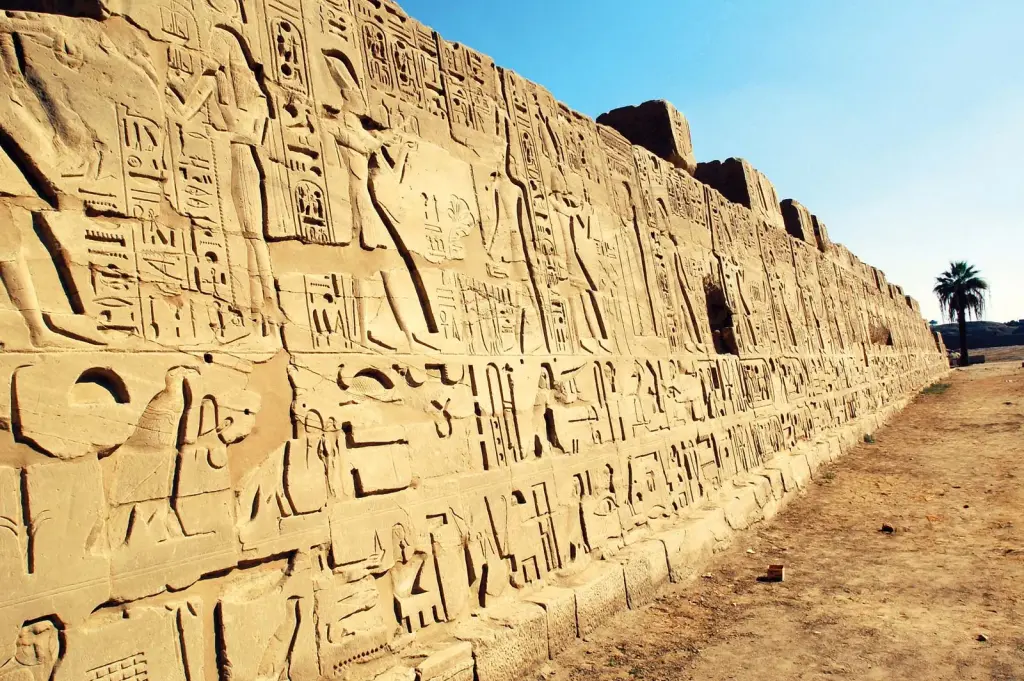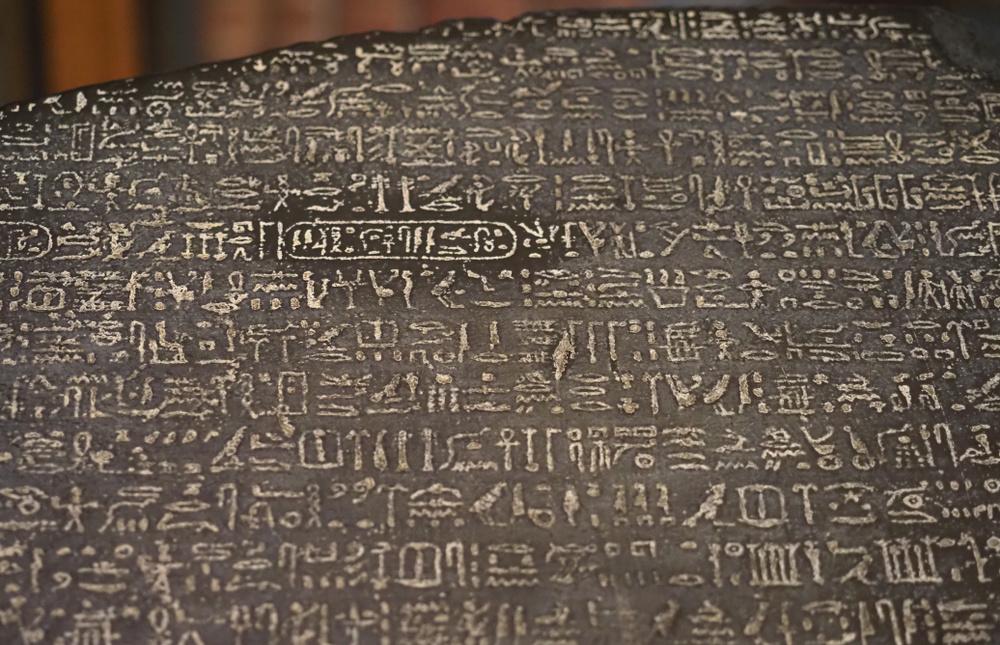Decipherment of the Hieroglyphs
Against such fruitless speculations the occasional acute observation of exceptional men de Guignes Warburton, and Carsten Niebuhr could avail but little in the absence of some definite clue to the decipherment of the ancient scripts. Such a clue was at last provided when some French soldiers, working on the foundations of a fortress at Rosetta came across a trilingual inscription in Greek, demotic, and hieroglyphic (1799). This inscription, ever since famous under the name of the Rosetta Stone, proved from its Greek portion to be a decree in honor of Ptolemy Epiphanes, which the priests of Egypt caused to be erected in all the temples of the land (196 B.C). Unhappily only a relatively small portion of the hieroglyphic text is preserved, and doubtless, it was for this reason, though partly also on account of the symbolic nature then attributed to the hieroglyphs, that scholars first directed their attention towards the demotic section. The stone itself had passed into the hands of the English, but a copy remained with the celebrated French orientalist Silvestre de Sacy.

After an abortive attempt of his own, de Sacy handed the copy on to the Swedish diplomatist Akerblad, a man of considerable attainments at that time devoting himself to oriental researches in Paris. Within the short space of two months Akerblad succeeded, by a comparison of the Greek and the demotic texts, in identifying in the latter all the proper names occurring in the former, besides recognizing, alphabetically written in their correct Coptic forms, the words for “temples” and for “Greeks”, together with the pronominal suffix for “him” and “his”. In the lettre a Mr. de Sacy, published in 1802, a first and most important step is taken towards the goal reached by Champollion just twenty years after. That Akerblad failed to make any further progress along the road where he had proved so admirable a pioneer was due to a prepossession from which he was unable to free himself; the words deciphered by him had been alphabetically written, and he, therefore, believed that the demotic writing was exclusively alphabetic.
The next great advance was due to an Englishman, no less a personage than the celebrated Thomas

Young, the author of the undulatory theory of light. A man of deep learning and wide interests, Young was ever ready to try a new puzzle; so when in 1814 a copy of the Rosetta Stone fell into his hands he attacked the problem with zest. While approving of Akerblad’s results so far as they went, he quickly realized that demotic teemed with signs that could not possibly be explained as alphabetic. Further, he grasped the fact that the demotic and hieroglyphic systems of writing were intimately related. Noticing, that the Greek section was full of words which repeated themselves, he used these as a basis for dividing up all three sections into their component words, and it was not long before his Greek-demotic vocabulary amounted to eighty-six groups, most of them correct, though his attempts to indicate the sounds of which they were composed and to adduce Coptic equivalents were as a rule mistaken. In 1816 he announced further discoveries obtained from material other than the Rosetta Stone. He had now identified long passages on papyri (belonging to the Book of the Dead) written in hieroglyphics and in hieratic, and so established the equivalence of the pictorial and cursive forms of the signs. He was certain that both demotic and hieroglyphic consisted largely of phonetic elements; and have demonstrated the fact, guessed long before by de Guignes and Zoega, that the cartouches or “royal rings” seen in the hieroglyphs contained the names of kings and queens, “very ingeniously” but rather luckily identified the cartouche of Berenice in addition to the known one of Ptolemy, and correctly suggested that another cartouche must be that of Tuthmosis of the XVIIIth dynasty. He also pointed out in hieroglyphic the alphabetic characters for f and t, and the “determinative” used in late texts for feminine names and recognized from variants in the papyri that different characters could have the same powers-in short, the principle of homophony. All this was mixed up with many false conclusions, but the method pursued was infallibly leading to
definite decipherment.

Meanwhile, Jean Francois Champollion, the young French scholar who was destined to win immortal fame as the decipherer of the hieroglyphs, had as yet but few positive results to record. Born at Figeac in the Department du Lot on the 23rd December 1790, Champollion’s interest in Egypt had awakened at a very early age. In his twelfth year he was already conversant with rudiments of Hebrew and Arabic, and from that time onward his enthusiasm for things oriental, warmly encouraged by his elder brother Jacques Joseph Champollion-Figeac, never flagged. His complete mastery of available materials enabled him to extend his discoveries with a speed and a sureness far beyond the scope of any of his contemporaries.

Passing over Champollion’s early writings, the first and most ambitious of which was the geographic portion, in two volumes, of a projected encyclopedic work to be called L’Egypt sous les Pharaons (1814). The close study had brought him the conviction that the three kinds of Egyptian writing were mere modifications of one another, and when, in the summer of 1821, he printed his brochure on the hieratic script, he had no difficulty in converting the demotic groups known to him into hieratic, and thence into hieroglyphics. With the name of Ptolemy both in hieroglyphics and in demotic, he was long since familiar from the Rosetta Stone, and about this time he became acquainted with the demotic papyrus Casati, where he found and, as his biographer assures us, at once transcribed into hieroglyphs a name which he rightly conjectured to be that of Cleopatra. Confirmation of this conjecture was, however, for the moment missing. In 1815 W. J. Bankes, exploring the temple of Philae, had discovered a base block covered with Greek inscriptions in honor of Ptolemy Physcon and the two Cleopatra, near to a fallen obelisk which appeared to have stood upon it. Both the base and the obelisk were transported to England in 1819 to adorn Mr. Bankes’s park at Kingston Lacy. A lithograph of the Greek and hieroglyphic inscriptions was made for Bankes in 1821, and in the following January Leronne forwarded to Champollion a copy with Young’s suggestion of Cleopatra scribbled by Bankes against the cartouche.

Akerblad had read the demotic name of Ptolemy alphabetically, and Champollion, though always inclined to hark back to his incompatible theory of the purely symbolic character of the hieroglyphs, had proved, by his identification of the demotic signs with those contained in the cartouche of Ptolemy, that the hieroglyphs also could, at least on occasion, be alphabetic. These the following months brought in unexpected abundance; among the cartouches successively transliterated and identified were of Alexander, Berenice, Tiberius, Domitian, and Trajan, besides others containing such imperial titles as Autocrator, Caesar, and Sebastos. The problem was thus solved so far as the cartouches of the Graeco-Roman period were concerned. But what about those belonging to the older times? Were the hieroglyphs of an earlier age also in part alphabetic, or were they wholly figurative, as Champollion had so often suspected? It was on the 14th September 1822 that he received from the architect Huyot copies of bas-reliefs in Egyptian temples which finally dispelled his doubts. He could recognize the names of pharaohs Ramses and Tuthmosis. From that moment onward each day brought its new harvest. Those discoveries, together with numberless others, were reserved for the marvelous Precis du systeme hieroglyphique, which appeared in 1824. Prolonged visits to Turin and to Egypt filled no small part of the remainder of Champollion’s short life. On the 4th March 1832, he died, at the early age of 41.
Lots of amazing Egyptologists and linguists completed the journey of Champollion as; Richard Lepsius, Samuel Birch, Heinrich Brugsch, Emmanuel de Rouge, Gaston Maspero, Adolf Erman, Henry Breasted, Griffith, and Alan Gardern.



-webp.webp)
-webp-webp.webp)
-webp-webp.webp)
-webp-webp.webp)
-webp-webp.webp)
-webp-webp.webp)
-webp-webp.webp)
-webp-webp.webp)
-webp-webp.webp)
-webp-webp.webp)
-webp-webp.webp)
-webp.webp)
-webp-webp.webp)
-webp-webp.webp)
-webp.webp)
-webp.webp)
-webp.webp)
-webp-webp.webp)
-webp.webp)
-webp-webp.webp)
-webp.webp)
-webp.webp)
-webp.webp)
-webp.webp)
-webp.webp)
-webp-webp.webp)
-webp-webp.webp)
-webp-webp.webp)
-webp-webp.webp)
-webp-webp.webp)
-webp-webp.webp)
-webp-webp.webp)
-webp.webp)
-webp-webp.webp)
-webp-webp.webp)
-webp-webp.webp)
-webp-webp.webp)
-webp-webp.webp)
-webp-webp.webp)
-webp-webp.webp)
-webp-webp.webp)
-webp-webp.webp)
-webp-webp.webp)
-webp-webp.webp)
-webp-webp.webp)
-webp-webp.webp)
-webp-webp.webp)
-webp.webp)
-webp.webp)
-webp.webp)
-webp.webp)



